Along with the alarming health crisis that the world is grappling with, COVID-19 has completely altered the way people work, particularly those in the organized sector. Most of the employees in this industry have continued to work during the lockdown, but from home (WFH). Now that it has been months into this phenomenal change, employers are speculating about the right time to reopen the businesses and get back to work.
Overnight, the luxury of working from home became a necessity. But, it is a great deal different than being in the office. People yet do not know how long it will take to get back to normal. And so, moving toward the eventual reopening of physical office spaces is certainly not a bed of roses! A ton of issues need to be addressed, all the possible outcomes - the entire situation has to be evaluated thoroughly. HR services play a significant role in making this transition as smooth as possible for both parties.
GoodFirms surveyed 168 businesses and employees worldwide to discover the challenges they expect while resuming office and the key considerations in designing a return to work plan.
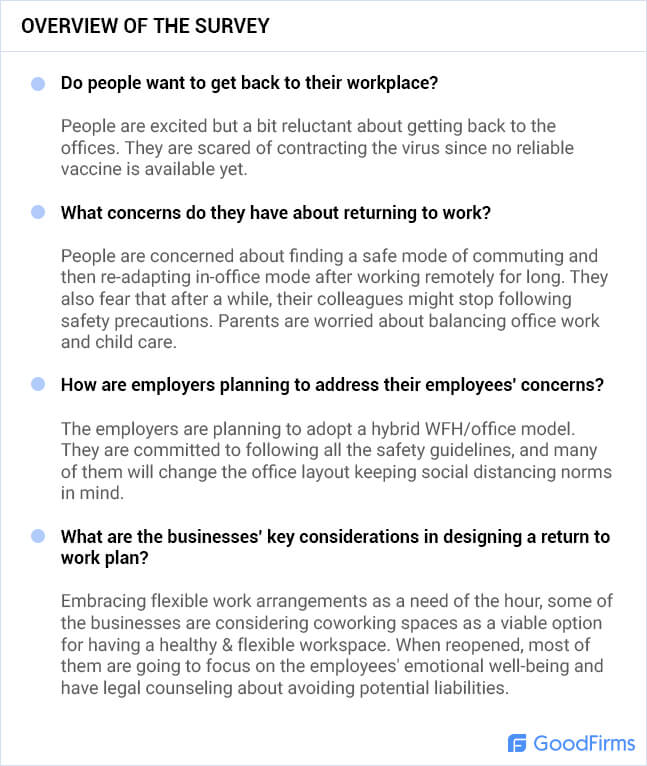
People Want To Return To Work, But They Have Concerns
Though work from home is not a practical option for industries such as hospitality, manufacturing, performing arts, it has been around for a while. Many organizations have been practicing WFH to a certain extent, much before the current outbreak.
During the lockdown, this course of action helped companies to have a head start on social distancing, limiting their exposure to the virus. After more than half a year into the situation, the question arises: Do people want to continue working from home or wish to return to work? 59.5% of the employees have expressed the desire to get back to their workplaces.

"Personally, I'm eager to return to the office," says Mikkel Andreassen, Customer Experience Manager at Dixa. On returning, he wants to be more positive and productive. Mikkel further adds, "Although there is a fear of getting sick, which is not surprising, I believe that getting back to work in the office would help me feel less anxious and moody."
Work relationships, whether with a manager or coworkers, are important for every employee, but rather than happening overnight, it evolves gradually over time through communication and establishing trust. James Ryan, President and Co-founder of Time For Homes, says, "Getting back to work in person is both exciting and terrifying. The interpersonal connections that are so hard to develop or maintain via messaging or video conferencing software are coming back to the foreground! Unfortunately, that means risking our health and that of our vulnerable loved ones."
People are eagerly waiting for the vaccine to end this ordeal. David Meltzer, CEO/Insurance Agent at East Insurance Group, says, "I feel a little reluctant to go back to work with there still being no vaccine. However, it feels better than staying at home. Going to work means I can work more efficiently and communicate better with my coworkers; human interaction is also refreshing ever since the lockdown."
What Concerns People The Most About Getting Back To Work?
Employees are keen on returning to the workplace to have face-to-face interactions with their colleagues again and for various other reasons that only positive workplace culture can provide. But, they are naturally concerned about the repercussions that office reopening can have in today's unpredictable environments. The main of their concerns are:
1) How To Ensure Safe Commuting To And From The Workplace?
Employees relying on public transit are afraid of contracting coronavirus on their commutes. Unless significant changes are made, maintaining the recommended 6 feet distance away from other people on public transportation, especially during peak hours, is impossible. 90% of Americans have accepted avoiding mass transit.
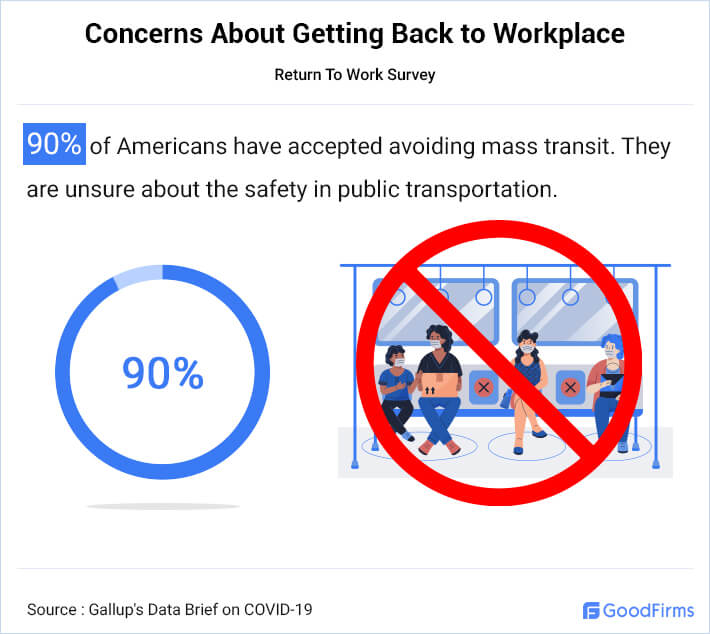
Cesar Contreras, Performance Marketing Executive at Advancio Inc., says, "In my case, I need to use public commute or take an Uber. And since some people are not ready to wear a mask and take the corresponding measures to maintain the COVID at bay, it feels like constant danger."
As many businesses are in the process of determining their strategy for getting employees back into the workplace, employers also acknowledge the commuting issue. Patrick Garde, Co-Founder & Technical Director at ExaWeb, says, "One of the challenges we expect is how our team members will be able to go to the office as our mass transportation is still unavailable. Also, assuming mass transportation becomes available, how can we make sure that they will be safe from the coronavirus. The only way to tackle the said challenges is to exercise safety and precaution."
There are some solutions to help the employers navigate the process of reintroducing employees to offices. "You can't fully address workplace safety without planning for a safe and flexible commute," says Sohier Hall, CEO at Luum. He acknowledges that even with lockdowns easing, transit ridership and commute activity is at all-time lows. Sohier informs, "There are several steps leading employers in tech., healthcare, education, and government are taking now, including:
- A move from monthly parking to daily parking passes.
- Closed-network carpooling and contact tracing
- Shuttle bus service with seat reservations with appropriate physical spacing and contact tracing.
- Using location- and commute-specific communications tools
- Offering rewards and incentives for "active" commute methods like cycling and using a scooter."
2) What If People Stop Following Safety Protocols Consequently?
Every country is asking its citizens to act responsibly to slow down the outbreak and minimize the pandemic's damaging effects. The majority of the entrepreneurs are also trying to inflict the same precautionary measures when it comes to running an organization. But there is a delicate balance between collective and individual responsibility.
63.5% of employees are afraid that once the offices recommence, after a few days of abiding by the rules, people will get back to the old ways.

"It's obvious to fall into the trap of believing everything's back to normal when in reality, it's not," says Stefan Chekanov, CEO and Co-founder of Brosix. He believes people need to have more consistent reminders to follow social distancing, mask-wearing, and other public health rules. Stephen explains, "I see that little by little; my colleagues are beginning to forget about them, which is human. That's where management should step in and act. I would be upset if instead management just dropped these precautions since fewer people are following them."
The strong possibility of people forgetting to act in accordance with the necessary safety measures can endanger themselves and those who are vulnerable. This leaves employers with the only option, which is to remind their employees about the rules continually.
Dan Bailey, President of WikiLawn, is also worried about people following the sanitation rules when everyone returns to the office. He says, "Right now employees need to wipe down their workstation at the beginning and end of the workday. They also need to wash their hands regularly, wear masks, and keep at least 6ft from one another at all times. We fear that normalcy will breed complacency, and these precautions will start to slip."
3) Parents - How To Find Balance Between Work And Child Care?
Owing to COVID-19, how and where people work has changed. And so, people, particularly parents, battle between unique clashes of work and child care, and find themselves walking on a tightrope. Their concerns are :
1. What if they go to work and bring back the infection?
It is difficult for parents to concentrate on office work with children being at home, but the thought of going to work and returning with infection also scares them.
Kate Diaz, Co-owner & Writer at Swanky Den, says, "As a parent, safety and fear are the biggest challenges. It's hard to eliminate the thought that you might go home with the virus anytime and infect your entire family. I think that this is a tough time for parents, especially those with younger kids."
2. How to find a child care center? What if they're exposed to viruses there?
Locating a place to send their children is also proving to be challenging. Many child care facilities are closed or operate with limited strength. And even if parents manage to send their kids to these centers, the fear of their children contracting the virus haunts them.
3. What will happen if their school reopens?
The uncertainty of their children's education is affecting parent's productivity. And even if the school reopens, they are wary of what health and safety measures the authorities will be adopting. Meanwhile, people working in educational sectors have their own set of challenges.
"I am fearful of how I will help my students learn maths while being 6 ft apart from them," says Aleka Shunk, Founder of Bite Sized Kitchen, a full-time 7th-grade math teacher in New Jersey. She is afraid that students are going to fall behind even more than they did in the Spring.
Giving the reasons, Aleka says, "There are going to be 500 students plus staff in the building at once with little air circulation. Half of my students will be there 4 days a week while the other half will be streaming live from home. We are expected to change classrooms each period, log into Google meet, take attendance, check and review homework, and teach a new lesson all in 30 minutes."
4) How To Switch From Remote Work To An In-office Mode?
Many governments and the local authorities worldwide have lifted the orders from pandemic lockdown, and businesses have started to reopen their offices. This presents another set of complications for the people who have adapted and molded themselves in a new WFH routine. 51.6% of the employees expressed concern regarding the transitioning from remote work to an in-office mode.

While working from home, people have control over schedule and work environment. They have the flexibility to meet the family needs, personal obligations, and other responsibilities at their convenience and accomplish office work accordingly. But everything changes once they are back to their workplaces.
Employers are also keeping this factor in mind and try to give them some time and flexibility. "The active energy in the employees can be seen as a bit depleted," says Eric Jones, CEO of Couture Candy. He acknowledges that it will be difficult for the employees to reacclimate to the office environment again.
Eric says, "The way to carry a conversation is also missing. The lack of face to face communication has led to the depletion of tactics used. People are suffering awkward silences and conversations with each other after getting back to work in the office. However, some team members are really energetic and are showing up great performances in the organization chart. Change differs from person to person."
Patience on the employers' part plays a crucial role in this adaptation procedure. Nikolina Jeric, the Founder of 2Date4Love, firmly believes that a gradual switch from remote work to an in-office work mode will enable their employees to adjust to a new routine more easily. She says, "I'm afraid our productivity will drop once we're back in the office, as I expect people to be overwhelmed with everything. I suppose many employees will feel tense or uncomfortable in the office initially, and we will have to be patient and organized to make this transition as smooth as possible."
How Businesses Are Planning To Bring The Employees Back?
Businesses do not want to force employees into the office without safety measures, an adjustment period, or a concrete plan. They are attempting to make all the necessary changes that can assure the employees about their well being.
1) Businesses Are Adapting Hybrid WFH/Office Model
While work from home provides flexibility and eliminates commuting, being in the office enables people to share knowledge, generate ideas, improve business relationships, and pool talents and perspectives. And that is why businesses have started adopting a hybrid model, where a workplace is split between WFH and office-based employees, with many employers allowing employees to decide where they want to work. 85.7% of businesses are cautiously making their way towards reopening the offices with a hybrid model.
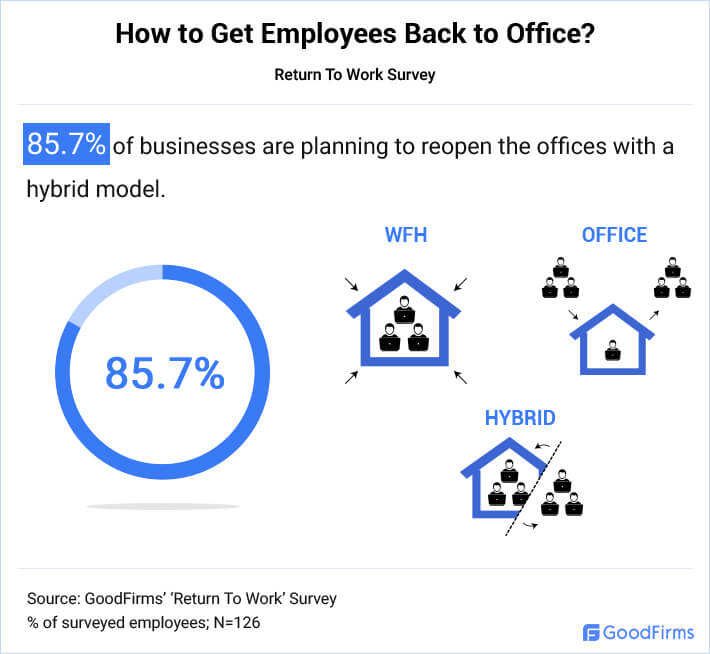
"We've started slowly transitioning back into the office," says Hosea Chang, Chief Operating Officer at Hayden Los Angeles. Not being someone leaving anything to chance, he says, "We were cautious about not having too many people in the office simultaneously, so we schedule them on different days or in shifts." Though Hosea is concerned that switching in and out of the office makes it hard for employees to get used to working in either environment because it's not consistent.
Many of the people living overseas are still WFH rather than returning to the countries they work in. Robin Brown, a Marketing Coordinator at Vivipins, says, "Still, not every employee is back to the office, but only those whose presence is mandatory are called back. The remaining team is working from remote locations, and the majority is of those who live overseas."
The hybrid WFH/office model helps to create a culture that engages professionals wherever they are. "During the pandemic, we worked fully remotely," says Akos Gabossy, CEO of PanIQ Room Franchising. Since July, they've implemented a new work-hour policy in the office.
Akos explains, "Employees need to come to the office 3 days a week - Tuesdays and Thursdays are fixed, and 2 days they WFH. In this way, we can have department meetings twice a week if necessary, and the rest of the days are flexible. We have only one rule: 8 hours need to be worked per day at their convenience."
2) Ensuring Safe Working Conditions
Governments and public health officials worldwide have implemented stringent measures to help contain the spread of coronavirus. In the majority of the countries, employers are expected to screen the health of employees, mostly as they begin a shift. These health screening steps also include asking employees about any consistent COVID-19 symptoms using a checklist or questionnaire. 71.4% of the businesses are adamant about ensuring safe working conditions for their staff.
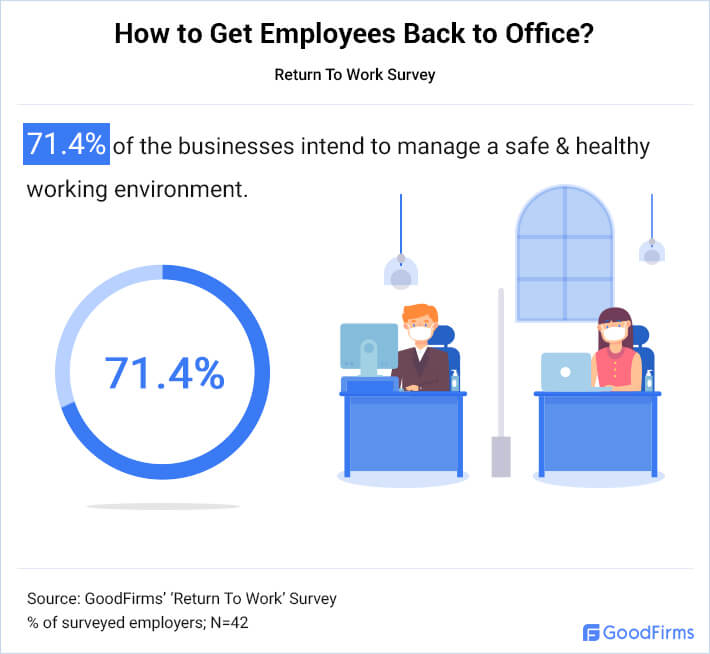
Denise Broady, COO of WorkForce Software, asserts that employers need to be proactive in mitigating the risk of exposing their employees to infection and creating a second wave of COVID-19 cases once workplaces recommence or expand operations. She says, "Putting an employee pre-shift health screening system in place for each employee before they start a shift can help control the further spread of coronavirus. Thermal imaging could allow employee temperature screening to prevent employees who may have a virus from starting their shift."
Employers need to develop an infectious disease preparedness and response plan - implement primary infection prevention measures, establish policies and procedures for instant identification and isolation of ill people, implement workplace controls to reduce the probability of exposure to COVID-19.
Before welcoming their employees back to the office, Robin Brown has reconsidered the employee monitoring and response plan that includes the strict processes of control. He expresses, "These processes involve the tracking of employee's absences due to any reason and also monitors the performance of the employees working currently. The plan also accompanies the flexible remote working policies and practices and overlooks the employees that can perform multiple functions when there is a reduced workforce."
Clean air indoors has become a necessity, and proper ventilation is the key to preventing the spread of COVID-19. Rameez Ghayas Usmani, Digital Marketing Executive at Purevpn, informs that most organizations are placing modern ventilators that can change recirculated air 20 to 30 times per hour, which recycle up to 50% of room air.
He says, "Air is usually recirculated around the workplace, enhancing the possibility of transmitting the virus between co-workers who are seated in the same area in a workplace through airborne droplets after you sneeze. Companies are making sure to install ventilation systems in offices by using filters to trap bacteria and viruses before the air is recirculated."
3) Office Layout Is Undergoing Significant Changes
The advantages of the mix of community, culture, connectivity, and spontaneity that one gets in the workplace make it irreplaceable. But, prior to reopening, the businesses are geared up to assess all the potential hazards in the workplace and then plan and implement necessary facility changes. CDC's resuming business toolkit features a checklist to help make recommencing of business operations maximum safe for everyone involved.
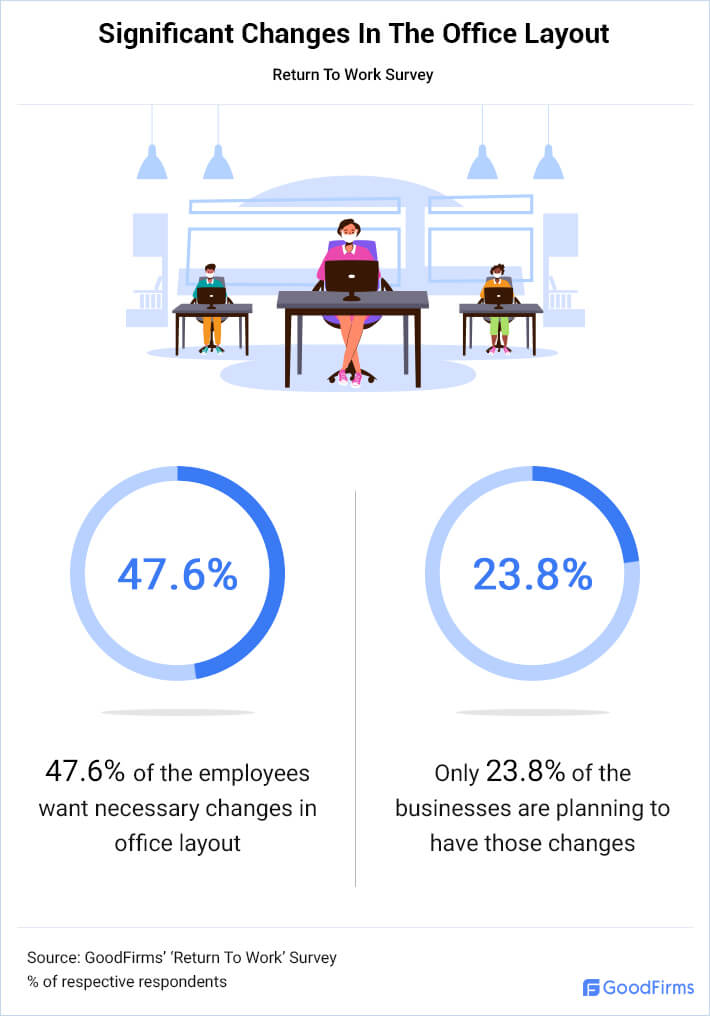
47.6% of the employees are keen on returning to the offices with the changed and well thought of layout. "We are expecting that our workplaces should look different and more welcoming," says CJ Xia, VP of Marketing & Sales at Boster Biological Technology. He believes that employers should ensure they are meeting their people's needs because that will ultimately fuel their business.
CJ further adds, "There should be a proper setup for us and our activities. Precise precautionary measurements should be taken, keeping in mind the security for our health. We want the employers to closely monitor the local health authority guidelines and listen to us."
23.8% of the businesses are going to invest in changing the office layout. Employers accept that when effective hand hygiene programs and other safety measures are neglected, the workplace can become a hotbed for bacterias and germs. Carol Li, Growth Marketer and Co-founder of CocoFax says, "It is important for each company to set related policies to protect everyone. For example, wearing masks in the office, providing disinfectant/hand sanitizer, checking everyone's temperature every day, and spacing out work stations at least six feet from other co-workers, etc. With these rules, employees will be much relieved to work."
Organizations are coming up with effective safety management that monitors whether social distancing is followed in common areas. Siddhartha Gupta, CEO of Mercer | Mettl, says, "We have a biometric attendance log that has to make way for facial recognition or retina scanners for no-touch or 6 feet distance compliance."
Siddhartha is contemplating how to make lunch/canteen arrangements for community lunch. He says, "We are thinking about whether or not to allow eating at workstations to check minimum interaction. But that fails the whole context of people's interaction and feelings of belongingness and coming back to work together."
Key Considerations For Developing Get Back To Work Action Plan
Each company needs a unique return to work plan, based on local requirements, location, number of employees, and its industry. It is also essential to design a return to work plan, which is sufficiently flexible to adapt to evolving recommendations, guidelines, and orders issued by federal, state, and local governments.
1) The Mental And Emotional Health Of The Employees
Employees' mental health is negatively affected by the organizational reforms, closure, and subsequent feeling of job insecurity and uncertainty.
Matt Scott, Owner of Termite Survey, advises, "Having your focus on your workforce's mental wellbeing is crucial, particularly during the tender few months when life begins to re-adjust again. There is a general fear that employers may not know the mental health burden lockout on the employee. Employees are worried that after reopening, workloads could all of a sudden be raised beyond their capacity to cope. Also, managers might ask them to take up new workloads – slack left over from lockout – albeit without added time or money."
2) Legal Counseling About Avoiding Potential Liabilities
Though there is no global consensus on how, when, and which businesses can reopen, organizations need to monitor their compliance with country-specific operation standards. They also must follow all the necessary guidelines to mitigate potential liabilities.
"It is important that all of the outlined health and safety protocols in your given state are closely followed," says Baruch Silvermann, CEO & Founder of The Smart Investor. He insists on having proper protective measures in place for both customers and workers.
Baruch says, "It is a good idea to check with your legal counsel about avoiding any potential liabilities. By sending a detailed list of health and safety precautions to all of your employees, you will give them assurance as well as peace of mind."
3) Coworking Spaces as an Option
Community strength is essential in helping people reconnect, build new networks, and support each other. Entrepreneurs, freelancers, consultants, and SMEs were already utilizing coworking spaces, but post-corona, even larger corporations who want to sustain the business, look for coworking spaces following all social distancing protocols and set across sprawling spaces.
Jesse Silkoff, Founder of MyRoofingPal, says, "We are not in a hurry to rush back until a good solution is found. But, we hope to resume at least meeting in coworking spaces eventually. There is an immense pressure to ensure that we pick an option that is safe and practical for everyone."
4) Flexibility
Moving forward into the next normal, companies are considering flexibility and choice as primary factors and contemplate investments into mobile cybersecurity tech, remote collaboration tools, workforce training programs, etc.
As businesses start determining a roadmap for the future of work, Denise Broady asks to put a system in place that enables employees anywhere in the world to access workforce management capabilities on any device, giving them increased flexibility. She says, "Flexibility to accommodate quickly changing, global regulatory requirements that provide unique benefits to remote socially distanced, sometimes quarantined, remote workers. Being able to clock-in or out, check schedules, request time off and manage your employees from the comfort of any setting you might be in at the time, whether it's at home, in the office, or the field provides the type of flexibility workers might need during this very uncertain time."
Conclusion
With the global workforce in the midst of a novel coronavirus situation, the majority of the employees in the organized sectors are working from home. And now, the businesses are contemplating how to navigate these volatile conditions, have employee monitoring & response plans, and physically reopen their enterprises.
Employees are both scared and excited to get back to a newly designed workspace with all the security measurements in place to open their minds, connect them with others, and encourage active collaboration again. But they are also afraid that the normalcy will make their colleagues forget to follow the primary social distancing etiquettes. Employees find public transportation unsafe and find it challenging to commute safely to the workplace. Working parents are struggling a lot to figure out how to achieve work and child care balance. Employers and employees - both are in favor of gradually switching to the hybrid model.
With a solid knowledge base and experience, management consultancies can help businesses figure out and streamline the operational strategies for reopening the offices. The GoodFirms list of the best ones will help you discover the apt firm for your enterprise.



